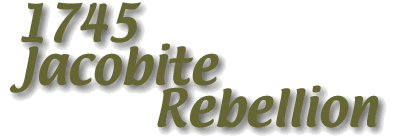|
The Highland clothing
of the period was really quite simple for all but those at the top of
the Clan structure. These were mostly people considered poor by
the rest of Great Britain, and they made almost everything they wore.
Fabric materials were extensively linen and wool. Silk and cotton
were expensive and less common; some blends were used. No other
fabrics were worn. This document only provides very basic Highland
clothing information. When assembling your clothing, remember the
class and vocation of the person you portray, and climate where they lived.
18th CENTURY SHOES AND FOOTWEAR:
There are many ways to come up with what appear to be mid 18th Century
shoes. Re-enactment grade period shoes are reasonably priced. Any
moderate sized used clothing store has shoes which can be reworked (with
a little imagination) into 18th Century foot wear. Gillies are very
easy to make, many people went barefoot. Discount stores sell shoes
which, with the addition of buckles from a fabric store, can well suffice.
You might even consider covering something you already have. What
is not acceptable are any shoes which clearly look modern: work or hiking
boots, Native American moccasins, tennis shoes, fur covered mukluks, or
sandals. Something appropriate is required. See men’s
and women’s clothing for more information.
EYEGLASSES, WATCHES, JEWELRY AND SKIN ART:
Many people who needed glasses in the 18th Century could not afford or
did not have them. One possibility if you do not have something
close to period glasses is to go without, and develop an accurate portrayal
accordingly. Some people who wear glasses at living history events do
not have 18th Century frames. It is understood that people make
the best of what they have, any round lense in a metal frame (not bright
gold) would be good. This is something you need to think about if
you plan upon portraying the 18th Century very often. Reproduction
frames have become very reasonable in price. Do not wear inappropriate
glasses or sunglasses.
Most of the Celtic jewelry on the market today is inappropriate
for 1745. Any jewelry should be appropriate to the time period,
and especially to the character you portray. Very little jewelry
was worn. Remember to remove wristwatches and modern earrings or
rings. Pocket watches were upper class. Except for character appropriate
earrings, please remove all pierced body ornamentation.
Tattoos are not appropriate for Highlanders. This should not be
a problem however, because properly dressed men and women would only have
the skin exposed on the face and hands (well yes, knees too on men.)
Woad was not being painted on in 1745.
FAMILY TARTANS AND TARTAN MATERIAL:
Family tartans, as we know them today, were essentially unheard of in
the mid 18th Century. Some families wore similar colors or patterns,
but the “this and only this is your family tartan” phenomenon
began in the19th Century. If you feel strongly about wearing family
tartan go ahead, but do not claim it to be such.
Modern family tartan is exorbitantly priced and rarely an appropriate
weight for this time period. Consider wearing a kilt or clothing
made from something without a pedigree. You can pick up tartan at fabric
stores or bargain bins for as little as $2 a yard. You will not
be nearly as squeamish about the abuse it may take as you are with family
tartan at $50 to $100 a yard. Darker, earth tones are good; remember
the colors were dyed from local plants and the garment was sometimes used
as camouflage. Brown, green, blue, purple, and rust are common.
Bright reds were expensive and less common. Men are encouraged to wear
many different tartans at the same time (coat, waistcoat, kilt, socks
all different), as this is the most authentic.
|
